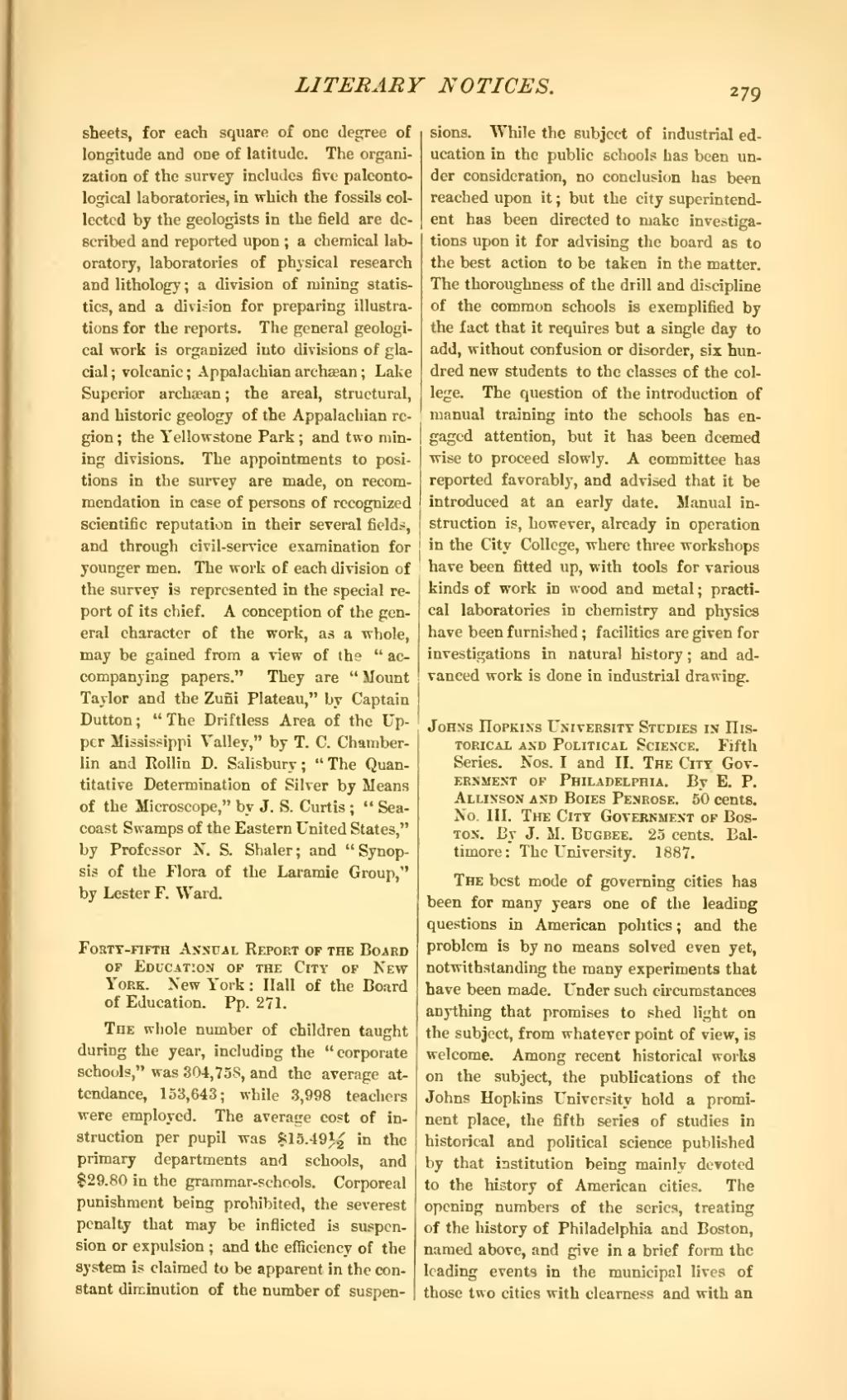sheets, for each square of one degree of longitude and one of latitude. The organization of the survey includes five paleontological laboratories, in which the fossils collected by the geologists in the field are described and reported upon; a chemical laboratory, laboratories of physical research and lithology; a division of mining statistics, and a division for preparing illustrations for the reports. The general geological work is organized into divisions of glacial; volcanic; Appalachian archæan; Lake Superior archæan; the areal, structural, and historic geology of the Appalachian region; the Yellowstone Park; and two mining divisions. The appointments to positions in the survey are made, on recommendation in case of persons of recognized scientific reputation in their several fields, and through civil-service examination for younger men. The work of each division of the survey is represented in the special report of its chief. A conception of the general character of the work, as a whole, may be gained from a view of the "accompanying papers." They are "Mount Taylor and the Zuñi Plateau," by Captain Button; "The Driftless Area of the Upper Mississippi Valley," by T. C. Chamberlin and Rollin D. Salisbury; "The Quantitative Determination of Silver by Means of the Microscope," by J. S. Curtis; "Seacoast Swamps of the Eastern United States," by Professor N. S. Shaler; and "Synopsis of the Flora of the Laramie Group," by Lester F. Ward.
Forty-fifth Annual Report of the Board of Education of the City of New York. New York: Hall of the Board of Education. Pp. 271.
The whole number of children taught during the year, including the "corporate schools," was 304,758, and the average attendance, 153,643; while 3,998 teachers were employed. The average cost of instruction per pupil was $15.4912 in the primary departments and schools, and $29.80 in the grammar-schools. Corporeal punishment being prohibited, the severest penalty that may be inflicted is suspension or expulsion; and the efficiency of the system is claimed to be apparent in the constant diminution of the number of suspensions. While the subject of industrial education in the public schools has been under consideration, no conclusion has been reached upon it; but the city superintendent has been directed to make investigations upon it for advising the board as to the best action to be taken in the matter. The thoroughness of the drill and discipline of the common schools is exemplified by the fact that it requires but a single day to add, without confusion or disorder, six hundred new students to the classes of the college. The question of the introduction of manual training into the schools has engaged attention, but it has been deemed wise to proceed slowly. A committee has reported favorably, and advised that it be introduced at an early date. Manual instruction is, however, already in operation in the City College, where three workshops have been fitted up, with tools for various kinds of work in wood and metal; practical laboratories in chemistry and physics have been furnished; facilities are given for investigations in natural history; and advanced work is done in industrial drawing.
Johns Hopkins University Studies in Historical AND Political Science. Fifth Series. Nos. I and II, The City Government of Philadelphia. By E. P. Allinson and Boies Penrose. 50 cents. No. III. The City Government of Boston. By J. M. Bugbee. 25 cents. Baltimore: The University. 1887.
The best mode of governing cities has been for many years one of the leading questions in American politics; and the problem is by no means solved even yet, notwithstanding the many experiments that have been made. Under such circumstances anything that promises to shed light on the subject, from whatever point of view, is welcome. Among recent historical works on the subject, the publications of the Johns Hopkins University hold a prominent place, the fifth series of studies in historical and political science published by that institution being mainly devoted to the history of American cities. The opening numbers of the series, treating of the history of Philadelphia and Boston, named above, and give in a brief form the leading events in the municipal lives of those two cities with clearness and with an

